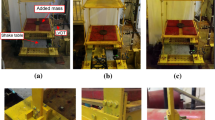Abstract
Excessive acceleration experienced at the top floors in a building during wind storms affect the serviceability of the building with respect to occupant comfort and discomfort. Tuned liquid damper (TLD) and multiple tuned liquid damper (MTLD), which are passive control devices consisting of a rigid tank filled with liquid, are used to suppress vibration of structures. These TLD and MTLD offer several potential advantages — low costs, easy installation in existing structures and effectiveness even for small-amplitude vibrations. This study carries out a theoretical estimation of the most effective damping ratios that can be achieved by TLD and MTLD. Damping by TLD an MTLD reduced the frequency response of high-rise buildings by approximately 40% in urban and suburban areas.
Similar content being viewed by others
References
Chen, Y. H., 1995, “Flexibility of TLD to High-Rise Building by Simple Experiment and Comparion,”Computer & Structures, Vol. 57, No. 5, pp. 855–861.
Fujino, Y. and Abe, M., 1993, “Design Formulas for Tuned Mass Dampers Based on a Perturbation Technique,”Earthquake Engineering and Structural Dynamics, Vol. 22, pp. 833–854.
Fujino, Y., 1993, “Vibration Control by Multiple Tuned Liquid Dampers (MTLDs),”Journal of Structural Engineering, Vol. 119, No. 12, pp. 3482–3502.
Fujino, Y., Sun, L. M., Pacheco, B. M. and Chaiseri, P., 1992, “Tuned Liquid Damper (TLD) for Suppressing Horizontal Motion of Structures,”Journal of Engineering Mechanics, (ASCE), Vol. 118, No. 10, pp. 2017–2030.
Kareem, A., 1990, “Reduction of Wind Induced Motion Utilizing a Tuned Sloshing Damper,”Journal of Wind Engineering and Industrial Aerodynamics, Vol. 36, pp. 725–737.
Kareem, A., Kijewski, T. and Tamura, Y., 1999, “Mitigation of Motion of Tall Buildings with Recent Applications,”Wind and Structures, Vol. 2, No. 3, pp. 201–251.
Modi, V. J. and Welt, F., 1987, “Vibration Control using Nutation Dampers,”Procceding International Conference on Flow Induced Vibrations, BHRA, England, pp. 369–376.
Noji, T. and Yoshida, H., 1988, “Study on Vibration Control Damper Utilizing Sloshing of Water,”Journal of Wind Engineering, No. 37, pp. 557–566.
Wakahara, T. and Fujono, Y., 1998, “A Simple Estimation of Across-Wind Response of Tall Buildings with Tuned Liquid Damper,”Journal of Wind Engineering and Industrial Aerodynamics, No. 76, pp. 37–54.
Author information
Authors and Affiliations
Corresponding author
Rights and permissions
About this article
Cite this article
Kim, YM., You, KP., Ko, NH. et al. Use of TLD and MTLD for control of wind-induced vibration of tall buildings. J Mech Sci Technol 20, 1346–1354 (2006). https://doi.org/10.1007/BF02915957
Received:
Revised:
Issue Date:
DOI: https://doi.org/10.1007/BF02915957




